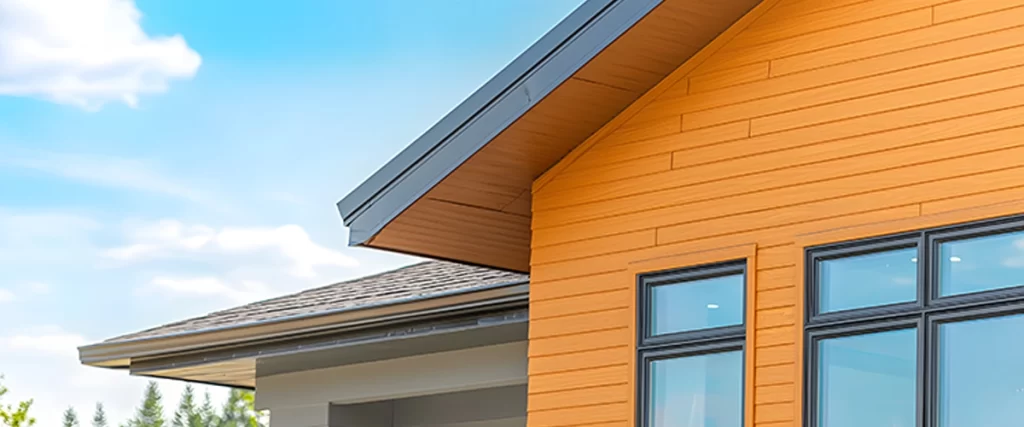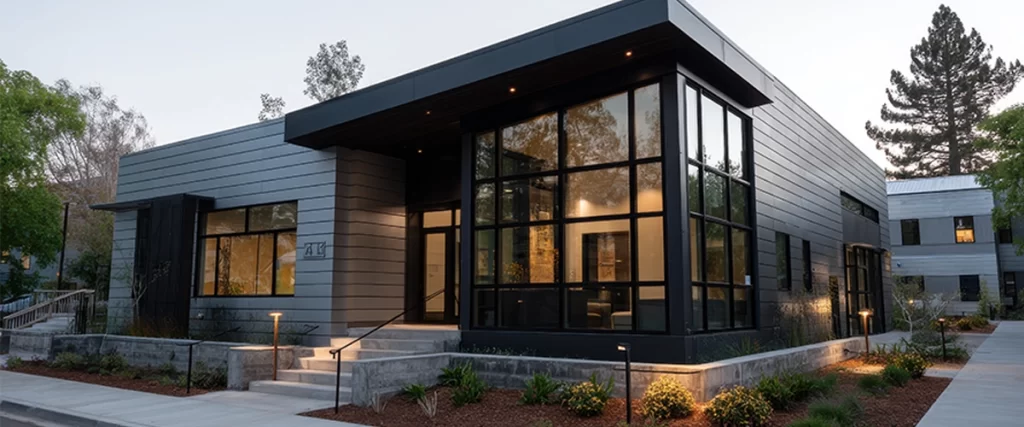When homeowners begin exploring options to update their home’s exterior, aluminum siding vs vinyl siding is often one of the first comparisons they face. Both are widely used, offer relatively low maintenance, and are more affordable than natural wood or fiber cement. But there are important differences in how they look, perform, and hold up over time.
Whether you’re planning siding repair or new construction, choosing between vinyl and aluminum siding depends on your budget, local climate, and your long-term expectations for the material. Each has its strengths, and each comes with trade-offs.
Let’s take a closer look at how vinyl siding compares to aluminum siding across categories like appearance, durability, energy efficiency, and cost.
Aluminum Siding vs Vinyl Siding: Pros and Cons
| Feature | Vinyl Siding | Aluminum Siding |
| Cost | More affordable overall | Slightly higher, especially for premium finishes |
| Style | Many colors and textures available | Limited style options, more industrial look |
| Durability | Resists moisture and pests | Handles heat well, fire-resistant |
| Maintenance | Low upkeep, easy to clean | May chalk or dent, could need repainting |
| Energy | Insulated options help with efficiency | Conducts heat unless paired with insulation |
| Installation | Easier and faster to install | Takes more time, requires careful handling |

Material Basics
What Is Vinyl Siding?
Vinyl siding installation is made from polyvinyl chloride (PVC) resin, often with added color pigments and UV inhibitors to prevent fading. It’s a popular siding material for residential homes thanks to its affordability, variety of color options, and relatively simple installation. Panels come in different textures and profiles to mimic wood or offer modern finishes.
What Is Aluminum Siding?
Aluminum siding is produced from rolled aluminum sheets, coated with paint or enamel. It gained popularity in the mid-20th century and is still found on many homes today. While not as widely installed on new homes as vinyl, aluminum brings advantages in certain climates and conditions.
Appearance and Style
Vinyl siding installation comes in more design options, finishes, and colors than aluminum. It offers textures that resemble wood board, shake, or even stone in some cases. Many homeowners choose vinyl to match their home’s style more closely, especially for modern or craftsman designs.
Aluminum has a metallic appearance that’s harder to disguise, even when painted. It offers a smooth or lightly textured finish but fewer style options. Some find its glossy finish attractive, while others feel it looks industrial or dated.
Durability and Performance
Weather Resistance
Vinyl handles most weather conditions well, but it can become brittle in extreme cold and may warp or melt with prolonged exposure to extreme heat. High temperatures near grills or fire pits can cause panels to soften or deform.
Aluminum stands up better to extreme temperatures and is fire-resistant. It doesn’t melt, making it a smart choice in areas prone to wildfires or heavy sun exposure. However, it can dent or scratch easily, especially during storms or when hit by debris.
Moisture and Mildew
Vinyl resists moisture damage and doesn’t rust or corrode. With proper ventilation behind it, mold and mildew growth are minimal. Aluminum also resists moisture but may oxidize over time, especially if the coating wears down. Oxidation can lead to chalky residue and faded color.
Pest Resistance
Both vinyl and aluminum are insect-resistant, unlike natural wood siding, which can attract termites or carpenter ants.
Energy Efficiency
Vinyl siding provides slightly better insulation out of the box, especially when paired with insulated backing. It can help reduce energy loss by adding a modest R-value to your home’s exterior.
Aluminum siding is fairly thin and conducts heat, which can allow cooled air inside to escape more easily during hot months unless it’s paired with added insulation. This may increase reliance on your furnace and air conditioner over time.
Maintenance
Vinyl requires minimal maintenance. Occasional rinsing with a garden hose or gentle wash with soap and water will remove dust and pollen. It resists fading well when exposed to sunlight, especially higher-grade products.
Aluminum needs more attention over time. Its finish can wear down, resulting in chalking or dullness. It may need repainting after several years, and scratches from branches or hail can expose the metal underneath. Cleaning aluminum is also simple, but care must be taken to avoid wearing away protective coatings.
Cost Comparison
Material Costs
Vinyl siding is typically less expensive. Basic vinyl siding runs between $2 to $5 per square foot for materials. Insulated versions or premium styles can go higher.
Aluminum siding usually costs $3 to $6 per square foot, depending on thickness, coating, and style. The cost of paint or enamel finish also affects the price.
Installation Costs
Vinyl siding repair is often faster and less labor-intensive. It’s lightweight and easier to cut, which leads to lower labor costs.
Aluminum siding is harder to handle and requires more precise cutting. It may also need custom paint touchups at seams or around cuts. This makes installation more time-consuming and sometimes more expensive.
Environmental Considerations
Vinyl is made from PVC, which raises questions for some homeowners concerned with environmental impact. While long-lasting, it is not biodegradable and can release harmful chemicals if burned.
Aluminum is fully recyclable, and some siding installation is manufactured from recycled materials. For those prioritizing sustainability, this may be a deciding factor.
Which Should You Choose?
Deciding between aluminum siding vs vinyl siding depends on what matters most for your home.
If your area experiences severe weather and you’re looking for a more durable surface with fire resistance, aluminum might offer better performance. If you’re looking for more design options, lower installation costs, and low maintenance, vinyl is likely the better fit.
Here are a few questions to help guide the decision:
- Does your climate have extreme temperatures?
- Do you want to avoid repainting or refinishing over time?
- Is curb appeal or matching other materials on your home important?
- Are you trying to reduce heating and cooling costs?
Both vinyl and aluminum siding can work well when installed properly and maintained regularly. The choice often comes down to your budget, priorities, and the style of your home.

Or Maybe You’d Rather Let Us Handle It
There’s a lot to compare. Material differences, cost per square foot, maintenance expectations, performance in different climates, it takes time to sort through it all. And once you decide, you still have to handle measurements, product selection, trim details, and siding installation.
If you’d rather not juggle all of that on your own, we’re here to help. Our team installs both vinyl and aluminum siding, and we’ve worked with hundreds of Omaha homeowners to get the results they wanted, without the stress.
Call us at (402) 651-1493 or Contact us. We’ll walk you through the options and take care of your siding project the right way.
